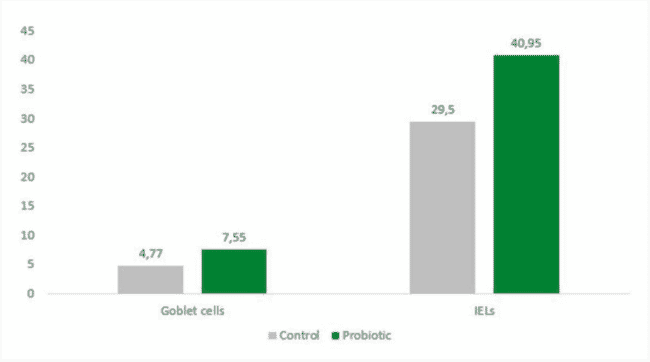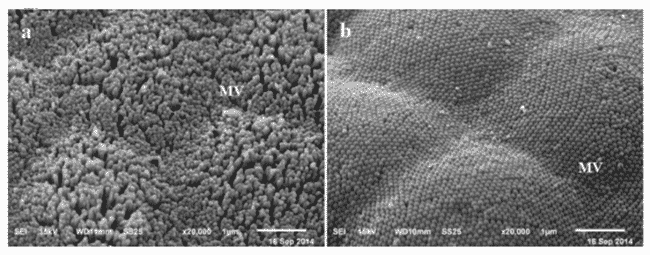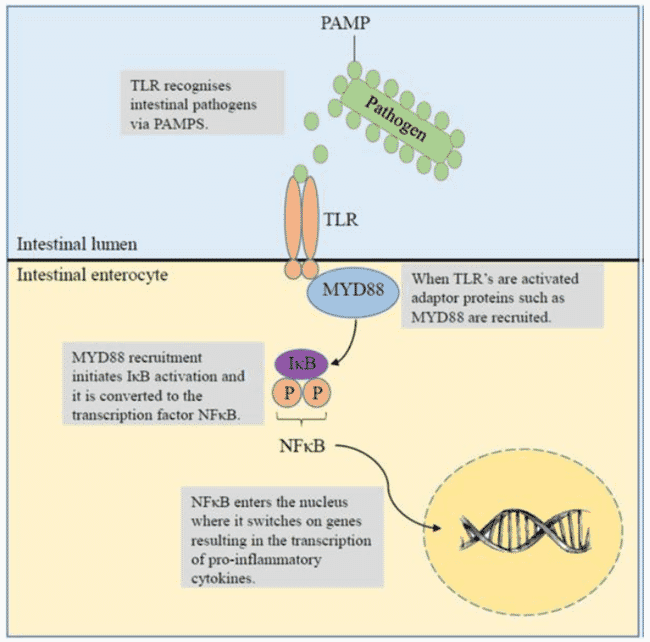Probiotics offer feed millers the opportunity to produce value added functional feeds. Once the feed is consumed, a successful probiotic will colonize the intestinal tract and exert a number of benefits, often relating to enhanced immunity and disease resistance.
The intestine is one of the main portals of entry for invading pathogens. In order to successfully infect the host, a pathogen must navigate and survive multiple obstacles and attacks, executed by the host’s immune system.
Innate immune response = 1st consideration
As with mammals, the fish immune system can be separated by innate (non-specific) and adaptive (specific) responses. Compared to mammals, fish are more dependent on the innate immune response for two main reasons. First, the innate immune system has developed to be non-specific and is therefore capable of mounting an immune response against a wide range of pathogens. Secondly, due to the ectothermic nature of fish, adaptive immunity can take considerable time. For example, antibody production in salmonids can take up to six weeks, compared to just hours or days for the innate immune system.
Reinforcing the first line of defense
The mucus layer produced by goblet cells provides the immediate line of defence. The mucus functions to trap and remove pathogens by providing both a physical and chemical barrier, since it contains a number of antimicrobial compounds. This mucus layer can be modified by the commensal microbiota as well as probiotic bacteria. For example, after feeding tilapia with a commercial probiotic for five weeks, it was discovered that there were approximately 60% more goblet cells in the intestine (Figure 1). These additional goblet cells could contribute to a greater production of mucus, thus providing a more impenetrable barrier, potentially retarding pathogens and preventing their attachment to the underlying epithelia.

© Biomin
Strengthening the barrier: microvilli density
Beneath the mucus layer, lies the epithelia, primarily consisting of enterocytes. These cells are lined with microvilli. Using electron microscopy, it was shown that the probiotic significantly increases microvilli density in the gut. The benefit of this increase is two-fold. First more numerous microvilli will increase the surface area so the host can acquire more nutrients from the feed. Second, any gaps between microvilli present an opportunity for pathogens to translocate the epithelia and infect the fish (Figure 2). Thus a higher microvilli density, caused by the probiotic, contributes to a more efficient barrier between the inside of the gut and the outside, blocking pathogens.

© Biomin
Larger leukocyte infantry
Assuming a pathogen was able to breach the epithelia, an army of white blood cells, collectively known as intra-epithelial leucocytes (IELs), would be waiting to attack the pathogen. Our research at Plymouth University consistently demonstrated that tilapia feeds supplemented with probiotics resulted in significantly larger populations of IEL. This increase was between 22-38% depending on the probiotic dosage, as well as the duration of feeding (Figure 1).
Better immune readiness
All pathogens express pathogen associated molecular patterns (PAMPs) on their cell surface. These are recognized by their respective receptor molecules such as TLR’s which notify the host on the pathogen type (i.e. bacterial, viral, fungal etc.; Figure 3). Intestinal gene expression analyses, show that probiotics can up-regulate the expression of TLR2 by approximately five-fold in tilapia. TLR2 is important for recognizing Gram-positive bacteria. This is particularly important because tilapia (along with many other warm water species) are susceptible to a number of Gram-positive infections, most notably Streptococcus.
Once activated, TLR’s initiate a number of molecular pathways which result in the production of pro-inflammatory cytokines. The same probiotic addition to tilapia diets caused an increase in pro-inflammatory gene expression, IL-1β and TNFα. These data are suggestive of a fish which is more prepared to fight off potential future pathogens since the host can recognize and clear the threat much more rapidly, thus it has greater immune readiness.
Getting the right balance
The gut is home to a large number of commensal microorganisms. It is important that these are protected by the host as they provide important functions in intestinal development, nutrition and immunity. Anti-inflammatory cytokines are part of a tolerance mechanism which acts to de-sensitize the host, thus it does not initiate an immune response to attack ‘good’ bacteria. Furthermore, they act to balance out the pro-inflammatory cytokines, thus maintaining an equilibrium within the mucosal immune system.
In vivo trials using tilapia, demonstrates that the gene expression of two anti-inflammatory genes, IL-10 and TGFβ, can also be increased by the addition of AquaStar® Growout. This result tells us two things; firstly, that the host does not see the probiotics as a threat and secondly that the probiotics can help to promote and maintain mucosal tolerance.

© Adapted from Cerf-Bensussan & Gaboriau-Routhiau, 2010
Overall immune fitness: an extension of gut health
If a pathogen is successful in overcoming the localized immune system (i.e. within the gut), it is then at the mercy of the systemic immune system. In fish, this is controlled by the head kidney. Therefore, head kidney tissues were also analyzed for immune related gene expression. Similar to the gut, RT-PCR analyses demonstrated that the gene expression of immunity genes (TLR2, pro- and anti-inflammatory) were all elevated in probiotic fed fish. This reveals that probiotics can have a wide reaching benefit on host immunity, not just in localized tissues where the initial exposure occurred, but also at the whole organism level.
Conclusion
Probiotics can improve the intestinal barrier function, promote a state of superior immune readiness and enhance tolerance mechanisms, both within the intestine and other immuno-important tissues. This opens the door to healthier animals, fewer instances of disease and less chemotherapeutical intervention in aquaculture production.
This article originally appeared on Aquafeed.com


